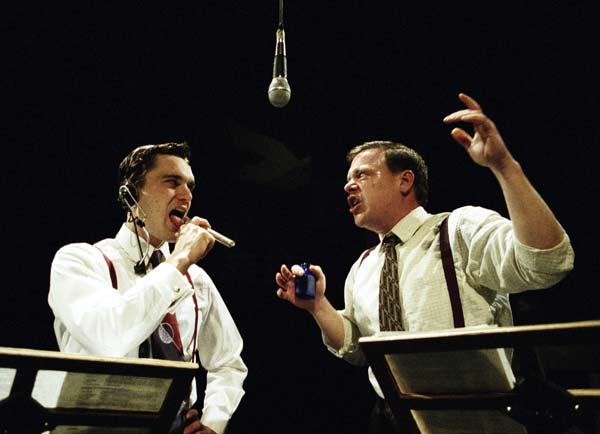 |
St. Christopher
by A. Shay Hahn • Directed and Designed by Vikki Anderson |
| March 31 – April 17, 2005 • Theatre Passe Muraille • Toronto |
|
|
| The plot of St. Christopher involves a proposed sale on a Toronto pier in 1949 of art stolen from the British Museum during WW2 by Tom, an idealistic ex-soldier from Winnipeg, sweetly played by Gray Powell, and his partner Markagh, a sociopathic Cockney ex-soldier tautly played by Philip Riccio.
The intended buyer is a wealthy Michigan businessman whose adventurous daughter, Miriam, played in Bette Davis style by Lisa Norton, escapes the seductive machinations of her father’s agent in the art sale deal (Ashley Wright) by beating him unconscious (at least) with a briefcase full of money. Miriam dresses up in the agent’s clothes, and flees the luxury cruise ship Noronic that brought her and her family to Toronto, hoping to find adventure, which she does by falling in (love) with the idealistic but crooked soldier from Winnipeg.
Will the deal go down? That is the question. During two tense scenes dominated by the menace of Markagh’s knife and a calamitous shipboard fire (true story), the lives and aspirations of all these people, so apparently separate, become seriously enmeshed, as if to remind us that we are all connected. The fire on the Noronic also serves to bring non-combatants to an appreciation of the fiery destruction of war.
|

Gray Powell and Ashley Wright |
|
Upon reflection, everyone in the play has the potential to be a killer and a crook. The play opens with two big crooks, Winston Churchill and Adolph Hitler doing a joint radio broadcast from hell, and ends with two big killers, Josef Stalin and Harry S. Truman, agreeing to take off their shoes and flick lighted matches at each other, simulating the ballistic missile threats of the so-called Cold War.
Andrew Shay Hahn’s vision is darkly ironic, though the direction brings out such a polarized innocence in the romantic leads and such menace in Markagh, that the play as a whole falls into melodrama. The first act could have a bit more starch in the collar; the ending dissipated the taut bowstring energy focused on Markagh's murderous intention. The direction calls for more shouting than I thought necessary to convey strong feeling, and the production could benefit from a European accent coach. Director Vikki Anderson’s 40’s period piece set, though cramped and uniformly dingy, remains in the mind as a vivid unit.
|
|
|
|
We welcome your comments and feedback
|
|
• • • • • •
|
|
| Report by Stanley Fefferman |
• •
|
for The Live Music Report
|
|
•
|
|
|
•
|
|
|
|
|


